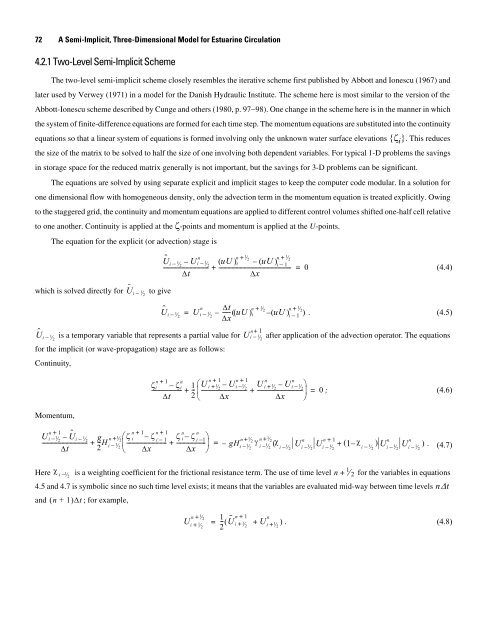A Semi-Implicit, Three-Dimensional Model for Estuarine ... - USGS
A Semi-Implicit, Three-Dimensional Model for Estuarine ... - USGS
A Semi-Implicit, Three-Dimensional Model for Estuarine ... - USGS
Create successful ePaper yourself
Turn your PDF publications into a flip-book with our unique Google optimized e-Paper software.
72 A <strong>Semi</strong>-<strong>Implicit</strong>, <strong>Three</strong>-<strong>Dimensional</strong> <strong>Model</strong> <strong>for</strong> <strong>Estuarine</strong> Circulation<br />
4.2.1 Two-Level <strong>Semi</strong>-<strong>Implicit</strong> Scheme<br />
The two-level semi-implicit scheme closely resembles the iterative scheme first published by Abbott and Ionescu (1967) and<br />
later used by Verwey (1971) in a model <strong>for</strong> the Danish Hydraulic Institute. The scheme here is most similar to the version of the<br />
Abbott-Ionescu scheme described by Cunge and others (1980, p. 97−98). One change in the scheme here is in the manner in which<br />
the system of finite-difference equations are <strong>for</strong>med <strong>for</strong> each time step. The momentum equations are substituted into the continuity<br />
equations so that a linear system of equations is <strong>for</strong>med involving only the unknown water surface elevations {ζ i }. This reduces<br />
the size of the matrix to be solved to half the size of one involving both dependent variables. For typical 1-D problems the savings<br />
in storage space <strong>for</strong> the reduced matrix generally is not important, but the savings <strong>for</strong> 3-D problems can be significant.<br />
The equations are solved by using separate explicit and implicit stages to keep the computer code modular. In a solution <strong>for</strong><br />
one dimensional flow with homogeneous density, only the advection term in the momentum equation is treated explicitly. Owing<br />
to the staggered grid, the continuity and momentum equations are applied to different control volumes shifted one-half cell relative<br />
to one another. Continuity is applied at the ζ-points and momentum is applied at the U-points.<br />
The equation <strong>for</strong> the explicit (or advection) stage is<br />
which is solved directly <strong>for</strong> Ûi – 1⁄ to give<br />
2<br />
Ûi – 1⁄ 2<br />
+ ⁄<br />
+ ⁄<br />
n<br />
n 1<br />
2<br />
n 1<br />
2<br />
Ûi – 1⁄ – U 2 i – 1⁄ ( uU ) 2<br />
i – ( uU ) i – 1<br />
--------------------------------- + ----------------------------------------------------- = 0<br />
(4.4)<br />
Δt<br />
Δx<br />
n<br />
Ûi – 1⁄ = U 2 i – 1⁄ 2<br />
– Δt n + 1⁄ 2 n + 1⁄ 2<br />
------ ( uU ) i – ( uU ) i – 1 ) .<br />
Δx<br />
n 1<br />
is a temporary variable that represents a partial value <strong>for</strong> U i – 1⁄ 2<br />
<strong>for</strong> the implicit (or wave-propagation) stage are as follows:<br />
Continuity,<br />
Momentum,<br />
(4.5)<br />
+ after application of the advection operator. The equations<br />
n + 1 n<br />
ζi – ζ i 1<br />
---------------------- --<br />
Δt 2<br />
U n + 1 n + 1<br />
i + 1⁄ – U 2 i – 1⁄ 2<br />
----------------------------------<br />
Δx<br />
U n<br />
n<br />
⎛ i + 1⁄ – U 2 i – 1⁄ ⎞<br />
2<br />
+ ⎜ + ---------------------------------- ⎟ = 0 ; (4.6)<br />
⎝ Δx ⎠<br />
n + 1<br />
n 1 n 1 n n<br />
U i – 1⁄ – Ûi 1<br />
2 – ⁄ 2 g n + 1⁄ ⎛ζ 2 i – ζ i 1<br />
--------------------------------- --H<br />
– ζ i – ζ i – ⎞ 1<br />
n + 1⁄ 2 n + 1<br />
+ i – 1⁄ ⎜---------------------------- + --------------------- ⎟ = – gH γ ⁄ 2 χ<br />
2<br />
i – 1⁄ 2 i – 1⁄ 2 i – 1⁄ 2<br />
U n n + 1<br />
i – 1 Ui 1 ⁄ 2 – ⁄ 2<br />
Δt<br />
Here χ i 1⁄ 2<br />
2<br />
+<br />
+<br />
⎝ Δx Δx ⎠<br />
1 χ n n<br />
( + ( – i – 1 )U ⁄ 2 i – 1 Ui 1 ⁄ 2 – ) .<br />
⁄ (4.7)<br />
2<br />
– is a weighting coefficient <strong>for</strong> the frictional resistance term. The use of time level n + 1<br />
2 <strong>for</strong> the variables in equations<br />
4.5 and 4.7 is symbolic since no such time level exists; it means that the variables are evaluated mid-way between time levels nΔt<br />
and ( n + 1)Δt<br />
; <strong>for</strong> example,<br />
+ ⁄ 1 n + 1 n<br />
= -- ( Ũ i + 1<br />
2 2 ⁄ + Ui + 1⁄ ) .<br />
(4.8)<br />
2<br />
n 1<br />
2<br />
Ui + 1⁄ 2<br />
⁄

















